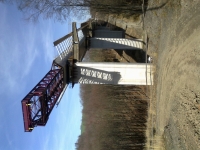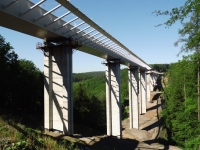Miscellaneous
Construction of bridges by incremental launching method
FIRESTA Company
USPA NEWS -
Construction of bridges by incremental launching method
In the year 2000 the FIRESTA Company added hydraulic manipulation of superstructures to its main construction activities with special focus on launching and lifting/lowering.
To provide these services, FIRESTA is equipped with several ENERPAC high pressure hydraulic systems which are used to launch, lift and lower bridge constructions. The total capacity of these systems exceeds 20 000 tonnes.
A selection of recent constructions is listed below:
Road I/11 Mokré Lazce, a road connecting Opava and Ostrava districts, Czech Republic
In addition to bridges built by falsework, FIRESTA produced and assembled bridge constructions of two largest structures in the whole project (SO 206 and SO 207). The method used was incremental launching. For both of them similar steel superstructures with concrete decks were designed. The steel superstructure was built in section behind abutment and pushed with bars and hydraulic hollow plunge cylinders with capacity of 4 x 150 tonnes and 2 x 100 tonnes. The launching of SO 206 amounted to the length of 329 m and the weight of 3 740 tonnes (main steel superstructure plus bottom part of the concrete.
In the year 2000 the FIRESTA Company added hydraulic manipulation of superstructures to its main construction activities with special focus on launching and lifting/lowering.
To provide these services, FIRESTA is equipped with several ENERPAC high pressure hydraulic systems which are used to launch, lift and lower bridge constructions. The total capacity of these systems exceeds 20 000 tonnes.
A selection of recent constructions is listed below:
Road I/11 Mokré Lazce, a road connecting Opava and Ostrava districts, Czech Republic
In addition to bridges built by falsework, FIRESTA produced and assembled bridge constructions of two largest structures in the whole project (SO 206 and SO 207). The method used was incremental launching. For both of them similar steel superstructures with concrete decks were designed. The steel superstructure was built in section behind abutment and pushed with bars and hydraulic hollow plunge cylinders with capacity of 4 x 150 tonnes and 2 x 100 tonnes. The launching of SO 206 amounted to the length of 329 m and the weight of 3 740 tonnes (main steel superstructure plus bottom part of the concrete.
The length of SO 207 was 530 metres and the weight of the steel superstructure was 3 293 tonnes. This superstructure was launched from both abutments and it was joined between piers P5 and P6. From abutment OP1 the longitudinal curvature consists of non-constant radius. Due to this, the top of the pier was assembled by temporary structures, which allowed managed transverse deviation up to 1.0 m.
The firm FIRESTA-Fiser, reconstruction, construction was established in Brno in 1990 as a private company.
It started its activities with only 10 employees.
In 1997 it was transformed into a joint stock company and currently employs more than 500 skilled core workers.
The firm FIRESTA-Fiser, reconstruction, construction was established in Brno in 1990 as a private company.
It started its activities with only 10 employees.
In 1997 it was transformed into a joint stock company and currently employs more than 500 skilled core workers.
The length of SO 207 was 530 metres and the weight of the steel superstructure was 3 293 tonnes. This superstructure was launched from both abutments and it was joined between piers P5 and P6. From abutment OP1 the longitudinal curvature consists of non-constant radius. Due to this, the top of the pier was assembled by temporary structures, which allowed managed transverse deviation up to 1.0 m.
The firm FIRESTA-Fišer, reconstruction, construction was established in Brno in 1990 as a private company.
It started its activities with only 10 employees.
In 1997 it was transformed into a joint stock company and currently employs more than 500 skilled core workers.
The firm FIRESTA-Fišer, reconstruction, construction was established in Brno in 1990 as a private company.
It started its activities with only 10 employees.
In 1997 it was transformed into a joint stock company and currently employs more than 500 skilled core workers.
Liability for this article lies with the author, who also holds the copyright. Editorial content from USPA may be quoted on other websites as long as the quote comprises no more than 5% of the entire text, is marked as such and the source is named (via hyperlink).







